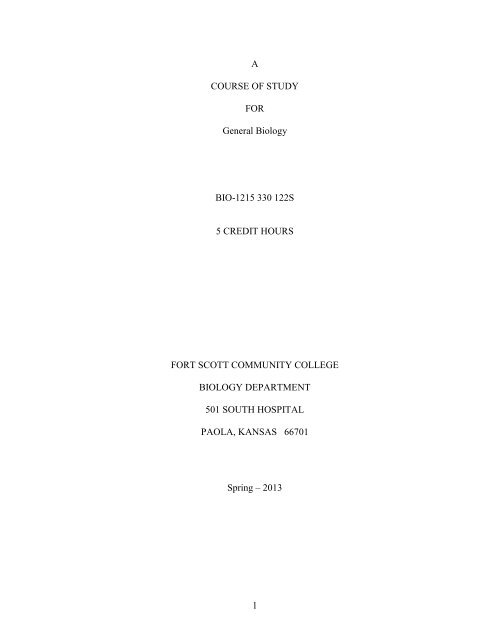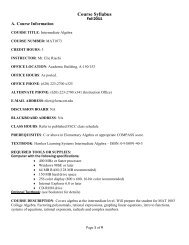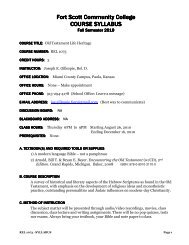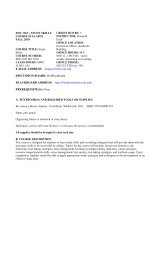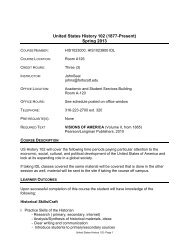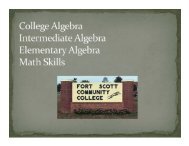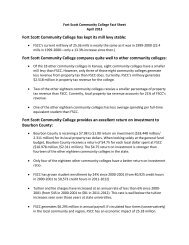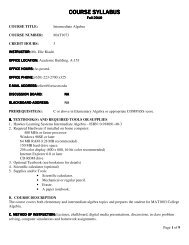Course Syllabus - Fort Scott Community College
Course Syllabus - Fort Scott Community College
Course Syllabus - Fort Scott Community College
You also want an ePaper? Increase the reach of your titles
YUMPU automatically turns print PDFs into web optimized ePapers that Google loves.
A<br />
COURSE OF STUDY<br />
FOR<br />
General Biology<br />
BIO-1215 330 122S<br />
5 CREDIT HOURS<br />
FORT SCOTT COMMUNITY COLLEGE<br />
BIOLOGY DEPARTMENT<br />
501 SOUTH HOSPITAL<br />
PAOLA, KANSAS 66701<br />
Spring – 2013<br />
1
A. <strong>Course</strong> Information<br />
COURSE TITLE:<br />
COURSE NUMBER:<br />
<strong>Course</strong> <strong>Syllabus</strong><br />
Spring – 2013<br />
General Biology<br />
BIO-1215 330 122S<br />
CREDIT HOURS: 5<br />
INSTRUCTOR:<br />
OFFICE HOURS:<br />
E-MAIL ADDRESS:<br />
CLASS HOURS:<br />
PREREQUISITES:<br />
Jack Treml, PhD<br />
By Appointment<br />
jtreml.fscc@gmail.com<br />
T/R 12-2:55pm<br />
None<br />
TEXTBOOK: Inquiry into Life, Sylvia Mader 13 th ed , McGraw Hill<br />
I encourage you to read the assigned chapters each week as a complement to our<br />
classroom discussion. All material from assigned chapters has the potential to show<br />
up on quizzes or exams regardless of whether we cover that material in class.<br />
Your Inner Fish, Neil Shubin<br />
We will read this book together, a chapter a week, with discussions at the end of class<br />
every Thursday. It is a well written, entertaining story of one biologist’s work to find<br />
remains of a critical transition species in evolutionary biology, I hope you will enjoy<br />
it. More importantly, it covers a number of topics that we will study this semester and<br />
includes additional information that we will not have time to discuss at length in<br />
class, but that I think will be beneficial to you.<br />
Additional readings may be made available on blackboard, in your course handbook or<br />
distributed in class.<br />
COURSE DESCRIPTION:<br />
This survey course includes three hours of lecture and two hours of lab. It is an<br />
introduction to the study of living things, including the nature of science, levels of<br />
organization and properties of life, bioenergetics, reproduction, genetics, evolution,<br />
classification and ecological/ environmental principles.<br />
2
B. METHOD OF INSTRUCTION:<br />
This is a lecture-based class. However, in addition to attending lecture, success of the<br />
student is dependent upon participation in in-class activities / assignments as well as<br />
completing assigned reading from both the textbook and other sources.<br />
C. COURSE COMPETENCIES/OBJECTIVES:<br />
Students performing at a “C” grade level or higher should be able to:<br />
1.<br />
[These are broad single, specific, one-dimensional behaviors; what we want students<br />
to learn. A competency/objective describes a performance that students should be<br />
able to exhibit before they are considered competent. Ten (10) or fewer are<br />
appropriate. <strong>Course</strong>s with statewide competencies may use them here.<br />
Competencies/objectives are clearly written, realistic, and learner focused.<br />
Competencies/objectives should state what the learner is to be able to do, under what<br />
conditions, and how well the student is to be able to do it. <strong>Course</strong><br />
competencies/objectives should reflect appropriate taxonomy based on course level.<br />
Developmental and freshman level courses should have competencies/objectives that<br />
are at the knowledge and comprehension level. Sophomore or higher level courses<br />
should have competencies/objectives at the application, analysis, synthesis, and<br />
evaluation taxonomy levels.]<br />
D. COURSE TOPICS/UNITS:<br />
Material covered is subject to change at the instructor’s discretion.<br />
Unit I: Introduction to the Cell<br />
In this section we will be introduced to the concept of life itself, discuss the ‘cell<br />
theory of life’ and examine how the cell is organized. In the second half of this unit<br />
we will discuss where the energy that fuels life on earth originates and how it is<br />
converted into usable energy. Finally, we will conclude with a discussion of how cells<br />
reproduce themselves to carry on life through the generations.<br />
Chapter 1: The Study of Life<br />
The cell theory of life<br />
What does it mean to be alive?<br />
Chapter 2: The Molecules of Cells<br />
Proteins, Fats and Carbohydrates<br />
Chapter 3: Cell Structure and Function<br />
Mitochondria and Chloroplasts<br />
ER, Golgi and vesicular travel<br />
Chapter 4: Membrane Structure and Function<br />
Chapter 6: Metabolism: Energy and Enzymes<br />
Chapter 8: Photosynthesis<br />
How do cells harness the energy of the sun?<br />
3
Chapter 7: Cellular Respiration<br />
How do cells convert food into usable energy?<br />
Chapter 5: Cell Division<br />
In order to grow, heal and reproduce, cells divide.<br />
Exam # 1<br />
Unit II: Heredity and Evolution<br />
In this unit we will discuss the process of heredity and how genes carry traits from<br />
one generation to the next. We will begin with a study of patterns of inheritance as<br />
elucidated by the work of Gregor Mendel with pea plants in the 19 th century. We’ll<br />
then examine the discovery of DNA as the genetic material and how this provides a<br />
molecular basis for heredity. We’ll explore how genetic information is translated into<br />
the proteins underlying the traits that we see, how these processes are regulated and<br />
the consequence of dysregulation. Finally, we’ll conclude with discussions of natural<br />
selection, evolution and population growth.<br />
Chapter 23: Patterns of Inheritance<br />
Mendelian genetics<br />
Chapter 24: DNA Biology and Technology<br />
DNA structure<br />
Gene expression<br />
Chapter 25: Control of Gene Expression and Cancer<br />
Chapter 26: Genetic Counseling<br />
Chromosomal disorders<br />
Chapter 27: Evolution of Life<br />
The origin of life<br />
Evidence of evolution<br />
Speciation<br />
Excerpts from of the following chapters<br />
Chapter 31: Human Evolution<br />
Chapter 32: Nature vs. nurture<br />
Chapter 33: Population growth<br />
Exam #2<br />
4
E. GRADING PLAN:<br />
Grading is established as a percentage of points earned from a number of sources. These<br />
include weekly quizzes, homework assignments, in class assignments and exams. Your<br />
grade will be determined by dividing the number of points you received on each<br />
assignment (etc.) by the total possible. This will result in a percentage score that<br />
determines your final letter grade<br />
Letter Grades will be determined using the following standard:<br />
90%+ = A<br />
80-90% = B<br />
70-80% = C<br />
60-70% = D<br />
F. ATTENDANCE POLICY:<br />
Attendance is required. We will be having regular quizzes throughout the semester. Any<br />
missed quizzes are NOT available for makeup. If you miss more than three classes during<br />
the semester for any reason, you may be dropped from the class.<br />
G. CLASSROOM RULES OF CONDUCT:<br />
I don’t think I need to tell you how to conduct yourselves. We all have the same goals<br />
in this class. Please do your best to meet those goals for yourself and help others to<br />
meet them with you.<br />
H. CELL PHONE USE:<br />
Cellphones, iPods, etc. are to be silenced or turned off upon entering class and left off<br />
while in attendance. If, for some reason, you receive an emergency call, please leave<br />
the classroom to attend to it. During tests I encourage you to leave your electronic<br />
devices at home or in your car.<br />
I. ACADEMIC INTEGRITY:<br />
Academic dishonesty will result in no credit given for the particular assignment, quiz,<br />
or exam, etc. and may result in referral for disciplinary action. Uncited references are<br />
not acceptable in any work – unless stated otherwise, when you put your name on a<br />
paper, it is assumed that ALL the work within is your own.<br />
J. MISCELLANEOUS:<br />
Extra Credit<br />
-Essays<br />
Each chapter poses critical thinking questions at the end of the summary / questions<br />
section. Several of these questions will be selected as extra credit opportunities that can<br />
be answered in the form of written essays. Well-considered essays can earn 1% toward<br />
your final grade.<br />
Extra credit will be added to your score at the end of the semester. At a maximum, you<br />
can improve your grade by only 50pts.<br />
Extra credit essays tend to get graded harder and I like to see very complete answers. You<br />
can always re-edit extra credit essays and re-submit. But please be sure to attach any<br />
previous graded copies with your re-submission so that I can be sure to give you<br />
additional points based on the new work that I ask for.<br />
5
Sign this page, detach from syllabus, and return to instructor.<br />
Semester<br />
Year<br />
<strong>Course</strong> Title:<br />
<strong>Course</strong> Number:<br />
General Biology<br />
BIO-1215 330 122S<br />
Credit Hours: 5<br />
Instructor:<br />
Office Hours:<br />
E-Mail Address:<br />
Jack Treml, PhD<br />
By Appt.<br />
jtreml.fscc@gmail.com<br />
Affidavit:<br />
My signature below indicates that I have read and understand this syllabus,<br />
and it has been made available either in hard copy or in an electronic format<br />
through the website and/or Blackboard.<br />
[Instructor may add specific statements related to his/her course.]<br />
______________________________________<br />
Student Signature<br />
_______________<br />
Date<br />
______________________________________<br />
Print Name<br />
______________________________________<br />
Print e-mail address*<br />
_________________________________<br />
Cell phone number*<br />
*Students must provide the Registrar’s Office with updated contact information.<br />
6


